|
Going forward in 2013, we are excited
to announce the restructuring of our tours into
three different groups. We will offer our Standard
Ranch Tour (three hours, meet individual animals
and sculpture); an Abbreviated Ranch Tour (two
hours, see groups of animals and sculptures); and
an Equine Educational Tour (three hours, meet
individual animals, view Rock Display and
sculptures). The Equine Edcucational Tour will
include not only a wealth of information on the
care, maintenance and training of equines, but
also a brand-new exhibit of our dearly departed
Rock's skeleton and the history of his
rehabilitation in relationship to our training
practice. The 2013 tours will also include a
new longears orientation video, complete with a
comprehensive history of the mule and amazing
archival photos and footage.
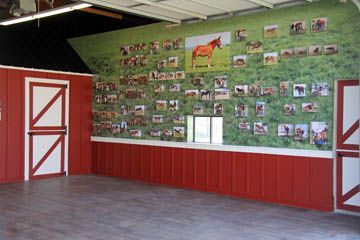
Look for us on
Facebook
and Twitter
Follow
Lucky Three Ranch on Twitter
and get the lowdown on
what's up!
And be part of the
longears
community---- share
your thoughts
with Meredith on
Facebook.
Be sure to click "like" to
join both the
Lucky Three Ranch and
the
Meredith Hodges fan
pages.
|
New!
Special
Christmas Gift Ideas!
Jasper
Reading Bundle, Jasper Movie Bundle and The
COMPLETE Jasper!
Featured
Product
Just
in time for
Christmas!
Whether
you're just starting out or you're ready for more
advanced training; whether your equine is a baby,
a beginner, or a seasoned performer, these
complete, comprehensive book or DVD "bundles"
offer you a priceless, lifelong resource so you
can train your equine the right way-the "Meredith
Hodges" way!
Now
Available - Training
Packages!

Package
1: Complete Training - everything you need
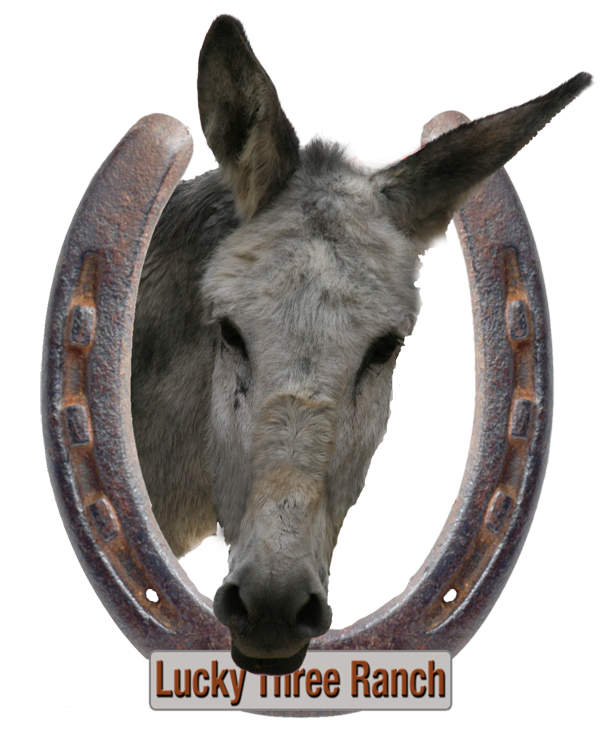 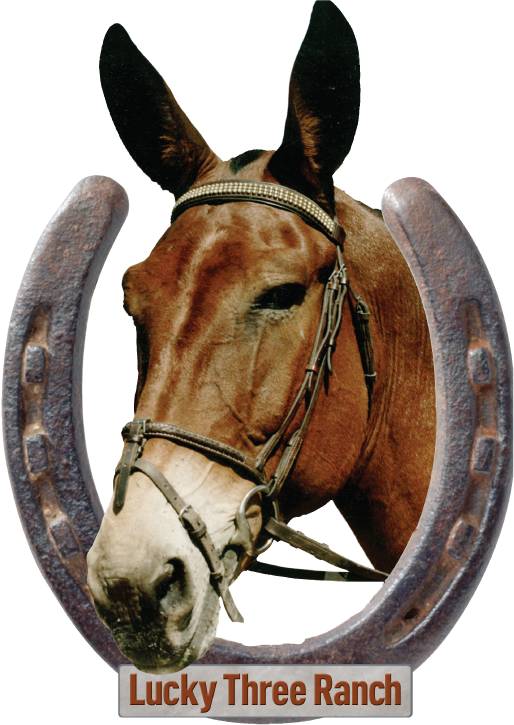
Package
2: Training from foal to adult and
beyond.
Package
3: A solid foundation for you and your equine
And
remember our Mule
Training
packages are great for your horses too!
|
Longears
Limelight
Mimi
Costley and Jim don't let the winter
weather slow down their progress. Leading training
is extremely beneficial for good posture
and
core
strength, and lots of fun
to do
together!
|
|

Dear
Friends,
Another
Mule Appreciation Day has come and gone, but our
appreciation for longears continues with many
new and exciting projects in the works!
Despite a summer and fall
persistently full of smoke and fires, we
had a record number of tours at the ranch this
year. Whether you are very young or not so
young, an experienced equestrian or meeting an
equine for the first time, interested in touring
as a single, a couple, a group or a whole
classroom, Lucky Three Ranch offers a unique and
educational experience for everyone. Many of
this year's tour groups were second-and
third-time attendees, and they tell us they are
never bored!
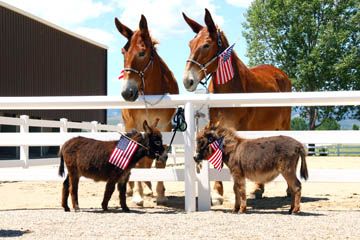
There are many exciting new
changes to both of our websites. Jasper the
Mule's website has a brand-new format,
with lots of fun interactive games and
activities for children and young-at-heart
adults.
There
are plenty of upgrades to our Lucky Three Ranch
website, as well. The
"Mule Crossing" articles are now archived and posted, and the
LTR website also gives you a link to my new
Training Tips videos on YouTube. In addition, the "What's
New?" section of our website features continual
updates about Lucky Three's
famous rescue draft mule, Roll, and
the exciting adventures of our mini
donkeys, Augie and Spuds. And, as always, all
submitted questions about longears are answered
solely by me, so you can be sure to get the
correct information you need promptly-when you
need it!
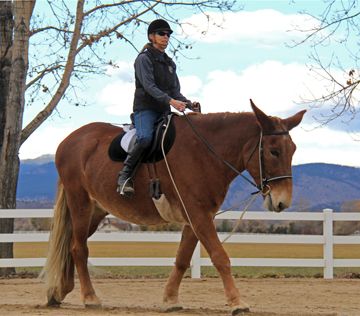
Roll continues to
improve and, in spite of side bones and ring
bone in all four feet, he is staying
sound, which is nothing short of amazing! He
is now
enjoying being ridden in the open arena, and he
is responding well enough to soon be able
to take short walks with the other mules around
the ranch to check fences and to do general
ranch work that is not too stressful for
him.
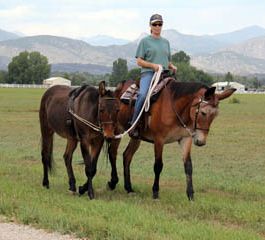
I am truly blessed to
still be able to enjoy my show mules and Little
Jack Horner into their old age. Our healthy
maintenance and training program has provided
longevity and increased practical use of these
animals in their retirement. They seem to really
enjoy their workouts together while they check
fences and the condition of the hayfields, and
make sure
nothing is broken and in need of repair on the
property. And, they seem to simply
enjoy the beauty, spaciousness and
serenity of their home. Lucky
Three Sundowner (now 32
years old) is still  the only mule to attain
Fourth Level Dressage; Lucky Three Mae Bea C.T.
(at 30 years old) is still the highest level
Combined Training mule to compete successfully
against horses; and Little Jack Horner (also 32
years old) is, still to this day, the only
donkey to reach Second Level Dressage, do
reining patterns with flying lead changes, spins
and slides, and jump four feet under saddle. the only mule to attain
Fourth Level Dressage; Lucky Three Mae Bea C.T.
(at 30 years old) is still the highest level
Combined Training mule to compete successfully
against horses; and Little Jack Horner (also 32
years old) is, still to this day, the only
donkey to reach Second Level Dressage, do
reining patterns with flying lead changes, spins
and slides, and jump four feet under saddle.
These
animals' incredible accomplishments are, as yet,
unmatched, and with their special talents, they
have paved the road for others to follow in
their footsteps. I am so proud to think that my
champions have encouraged others to reach for a
higher level of performance in the industry! I
am also very proud of people like American Mule
Association member Audrey Goldsmith and
her mule, Porter, who will continue
our mission by being outstanding ambassadors for
our breed. Mules and donkeys have been unjustly
maligned for way too long, but performances like
Porter's U.S.D.F. All-Breed 3rd Level Dressage
Champion, U.S.E.F. National Silver Stirrup Award
Champion for Zone 9, and U.S.E.F. Year End
Award Champion two years in a row against horses
(2010 and 2011) render the public speechless and
in awe of the longears' abilities!
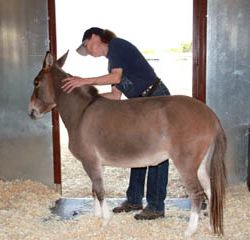 What I have learned from
my mules and donkeys over the years
has enabled me to make room for some rescue
animals that will also be able to live out their
lives in a healthier and more meaningful way. I
hope to continue this work for many years to
come, as the Loveland Longears Museum &
Sculpture Park at Lucky Three Ranch becomes a
reality. The mission of this non-profit entity
is to educate the public and future generations
about longears, and to provide ongoing care,
maintenance and training of equines by at-risk
and underprivileged children, and anyone else
who might be interested, thereby ensuring that
these magnificent animals will remain a
significant part of our culture for many years
to come. What I have learned from
my mules and donkeys over the years
has enabled me to make room for some rescue
animals that will also be able to live out their
lives in a healthier and more meaningful way. I
hope to continue this work for many years to
come, as the Loveland Longears Museum &
Sculpture Park at Lucky Three Ranch becomes a
reality. The mission of this non-profit entity
is to educate the public and future generations
about longears, and to provide ongoing care,
maintenance and training of equines by at-risk
and underprivileged children, and anyone else
who might be interested, thereby ensuring that
these magnificent animals will remain a
significant part of our culture for many years
to come.
Best
wishes and Happy Trails,
Meredith Hodges |
|
Question:
My
husband and I recently (two months ago)
purchased a Shetland and her foal. Her foal is
the offspring of a Mini-Donkey. So I believe the
baby would be called a Mini-Mule. I have just
recently began to work with her and she is so
nervous. She jumps and runs at the slightest
noise or quick movement. I would appreciate any
advice you can give on training her. Or if you
would recommend specific videos or DVDs I would
appreciate your input.
Thanks.
Answer:
No
matter what size, how old or how well-trained
the equine, they need time doing the simplest of
things to get to know you before they will learn
to trust and have confidence in you. Just as our
children need routine and ongoing learning while
they are growing up, so do mules and all other
equines. They need boundaries for their behavior
clearly outlined to minimize anxious and
inappropriate behaviors. The time together
during leading training (and going forward)
builds a good solid relationship with your
equine and fosters their confidence and trust in
you because you help them to feel
good.
I
do leading training for a full year to not only
get them to learn to lead and to develop a good
relationship with them, but also to develop good
posture and core muscle strength in preparation
for driving or for a rider. Even an older equine
with previous training still needs this for
optimum performance and longevity. During the
time you do the leading training strengthening
exercises, you should NOT ride or drive your
animal. If you ride or drive while you do these
exercises, it will not result in habitual
behavior and a new way of going, and will
inhibit the success of the exercises. The
lessons need to be routine, rewarded and done in
good posture to acquire the correct results. We
are building NEW habits in their way of moving,
and the only way that there can be change is
through routine, consistency in the routine and
correctness in the execution of the exercises.
Since this also requires that you be in good
posture as well, you will also reap the benefits
from this regimen. The result will be many years
to really enjoy each other's company! My
Training Mules and Donkeys DVDs and books can
help you to achieve your
goals! |
|
From
Our Readers:
|
|
Thank you so much for
replying to my email. Yes, there is truly
something very special about longears, as you
say. It seems a double edged sword, though, that
creatures soooo beautiful are so misunderstood
by humans. For me the beauty that they are
is like God speaking. There is such a feeling of
reverence when around them.
I
loved your story about Lucky Three Ciji! I don't
doubt she understood every word you
said. I'm not sure exactly how it works,
but understand they do. Even when driving
Coco I have to remember she can read my
mind! Words not required, thank you! I
think that words are only important to some
humans and that other creatures communicate in a
multi-channelled way. Many years ago when living
in Australia I learned Sign Language and found
that tuning into and reading faces and body
language really opened me up to understanding
non-humans as well. I always think it is a very
honest language. Without "forked-tongues"
as the American Indians are want to express
it. Anyway, thank you for Ciji's story also
and I am so grateful for your fulsome books and
DVDs, etc. on the education and psychology of
such soulful beautiful people. I have learned a
lot from you and I always appreciate the way you
generously give your time to our donkey and mule
training questions. One day I hope to visit
Monument Valley and while in that part of the
world would like to take a detour and take a
tour on your beautiful ranch. Here's
hoping!
Thank
you again, Meredith.
Best
wishes always to you and all of your
equines,
Kind
regards
J. |
|
Bonnie's
Bit

September
started off at a dead run and then it got
faster. Labor Day found me and my dog,
Elizabeth, and the pop-up on the grounds of the
Colfax (WA) steam threshing. Yes, steam
threshing. The old way. Mules and horses,
wagons, sweating guys. Dust, noise. It is
AWESOME. And, this year I had talked my dear
friends, Nancy and Mike Kerson (Video Mike) to
come and document the thing. We had a great time
camping next to one another and watching the
Overmeyers work out their four-, six- and
eight-mule hitch the night before the
thrashing.
The next morning dawned sunny and
clear, after some serious wind the day before,
and everyone was on the grounds ready to do this
thing. They've been doing this for just over 30
years now, having worked the ground and planted
the spring wheat the third week in April with
the teams and the old equipment.
Steam was building in the old Case
engine and the "push header" was readied for the
six beautiful grey mules to be hooked up. All
this is an amazing process and takes lots of
skilled help and tools. The header is "pushed"
by the six mules pulling on the hitch bar, with
the cutting head and the sweep right in front of
their noses. There are three mules on either
side of the tongue, and to watch them maneuver
the 90-degree corners is a study in cooperation
and calmness on their part. You gotta see it
some time, and Video Mike can fix you up. The
resulting DVD is just wonderful and informative
and educational and fun. It will put your
soul back together-at least for a while.
From Colfax, it was off to
Enterprise, OR and Hells Canyon Mule Days with
my buddy, Cheryl Mundee, and Elizabeth the dog.
Yes, Lizzy does get around. I think she has her
own fan club out there, too. Anyway, poor Video
Mike had to be there, too, so the good times
just kept coming for us. And, yes, there is a
Video Mike DVD of Hells Canyon Mule Days
2012.
Got about a week off and then it
was time for the big draft horse/mule show here
in Sandpoint. No rest for the wicked. The
weather was outstanding and the horses and mules
were, too. I was hoping the weather would hold
on long enough for us to get a ride or two in in
the local mountains before it set in with the
fall rains up here.
Well, we got one in, anyway, and
it was my first real trail ride on my new mule,
Iris. I can report she is just wonderful on the
trail. We got into a little bit of snow up there
on top of Trail Creek and there were all kinds
of tracks in the snow as we rode the old logging
road. THEN, we rode upon wolf tracks and Lucille
(my husband's mule) and Iris both registered
alarm and reluctance to continue. About that
time, some friends rode up on us and, with the
added security of other animals, our two mules
agreed to continue. We did ride up on a
young bull moose, but no one was upset by that
and we had another wonderful ride to say good by
to the season under our belt.
Since then, I have been working on
paintings and painting up my mule and donkey
Christmas ornaments in preparation for Cowboy
Christmas in Las Vegas during NFR.
In the meantime, It's a Merry
Christmas When Pigs Fly is now out on
Amazon as an e-book, and author Patsy Trigg has
put the music video on you-tube. Check
it out!
Have a
great holiday season,
Bonnie
|
Greetings
from the ADMS

As
the saying goes, it's hard to believe the year
is drawing to a close already. Fall is
definitely in the air, Hallowe'en decorations
are already out of the stores, and everyone is
looking forward to the big holidays with their
family and friends.
To those who have lost family and
friends this year, you have our sympathy and
support. Having been down that road with
our own, we know how hard it is to cope with the
holidays! A simple nod, a smile, and then go out
and have a good session with your animals for
some therapy! Believe it or not, they do know
your moods, and can tell when you need some
"cuddle time."
Make sure they all have a cozy
place for the winter, whether it be a nice
windbreak (where snow and ice aren't usually a
problem) or a snug barn. Water can be a concern
in wintertime, so best to lay out plans and
backup plans before the bad weather hits. Water
doesn't have to be warm, but it cannot be
frozen! Check your pipes and their wrappings
now, instead of finding out you have a problem
the morning after the big freeze hits.
To blanket or not to blanket-that
is a big question we get here as well. The
answer depends on a number of factors. If you
are keeping an animal clipped for show, you may
need to blanket. There are modified clips-those
that do not encompass the entire body-that help
protect the animal but leave areas clipped short
to allow hard-working animals to dry out easier.
Most of our longears owners do not use trace or
hunter clips, but instead do full-body clips, so
this would mean most definitely blanket and
shelter in the worst weather. Remember that
Mother Nature usually allows the equine to grow
the coat they need for protection in the
environment they are used to. Now, if you have
just obtained a new animal from a different
region, they may need a bit of help. But also
keep in mind that blanketing when it is not
really necessary will cause the internal
"control" of the animal to be thrown off,
meaning more work for you in the long run.
Should you increase feed? Not
necessarily. Free choice hay is usually fine for
all sizes, types and ages of longears, but don't
up grains or pelleted foods unless an animal
truly needs it. If they are standing around
doing nothing but eating, you may find you have
an animal with ill-fitting tack come spring!
Don't give them too much in the
way of treats over the holidays either! Just
because people love to have big spreads in
November and December does NOT mean that your
longears need holiday buffets as well. The days
have no special meaning to them, other than that
you may be happy, so they don't need an extra
bucket of apples, or pounds of carrots, or cakes
and cookies. If you must have a "party"
then cut up carrots or apples and dole out
sparingly. Don't go overboard!
Cold weather keeping you indoors
is also a good time to catch up on any
paperwork. Stud reports, filing,
transfers, new registrations, updating farm
records, updating or writing a will, anything
that you have been putting off. When was the
last time you rubbed a little neatsfoot oil over
your halters, saddle or harness? Take one of
those cold blustery days and sit back with your
favorite movie and a sponge. (Do it early enough
and anything that truly has to be replaced can
still make it onto your wish list!)
Above all, be safe on the roads,
whether with your animals or traveling alone.
Keep an eye on the weather, plan for emergencies
and drive with care. Your family and animals
will want you to be there for many years to
come!
Happy holidays, and warm nights
for everyone,
Leah
Patton,
office manager, ADMS
The
Am. Donkey & Mule Soc. PO Box 1210,
Lewisville TX 75067 (972) 219-0781.
Newsletter: the BRAYER magazine, 100+ pgs
6X/yr, $23 US, $30 Canada, $45 overseas. We now
accept Paypal, Visa/MC (+$1 courtesy fee
appreciated). Reg info, forms, fees on our
website at www.lovelongears.com.
| | |